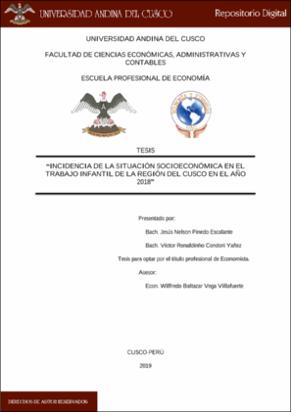| dc.contributor.advisor | Vega Villafuerte, Wilfredo Baltazar | |
| dc.contributor.author | Pinedo Escalante, Jesús Nelson | |
| dc.contributor.author | Condori Yañez, Víctor Ronaldinho | |
| dc.date.accessioned | 2021-02-09T23:42:27Z | |
| dc.date.available | 2021-02-09T23:42:27Z | |
| dc.date.issued | 2019-12-19 | |
| dc.identifier.uri | https://hdl.handle.net/20.500.12557/3658 | |
| dc.description.abstract | La presente investigación busca identificar de qué manera la condición
socioeconómica de las familias ha generado trabajo infantil en la región del Cusco durante
el año 2018. El trabajo infantil es alarmante, ya que en muchos casos la gran mayoría de
estos niños y adolescentes se encuentran laborando en actividades que son ilegales tales
como la prostitución, minería ilegal entre otros. Por otro lado, se estima que la tasa de
trabajo infantil en Perú es de 21,8%, la más alta en Sudamérica. Frente a esta situación,
se hace relevante conocer cómo la situación socioeconómica ha causado trabajo infantil.
Se utilizaron los datos de la Encuesta Nacional de hogares (ENAHO) de INEI del
año 2018, con un diseño no experimental. La ENAHO incluye el tipo de actividad
realizada y el número de menores entre 5 y 14 años que trabajan. Se utiliza el modelo
logit multivariado para identificar el efecto de la condición socioeconómica de las
familias en la probabilidad de trabajar. Entre los resultados más relevantes de la
investigación, se encuentra que el Trabajo Infantil es generado por la condición
socioeconómica de las familias en la región del Cusco. El nivel de ingreso del hogar, el
nivel de educación y la zona de residencia influyen en el nivel de trabajo infantil y son
estadísticamente significativos. El nivel de ingreso de la familia incide de manera
negativa en el nivel de trabajo infantil de la región del Cusco, ya que la probabilidad de
trabajar se reduce por un factor de 0,97 cuando el ingreso aumenta en 100 soles; efecto
es estadísticamente significativo. El nivel de educación incide de manera negativa en el
trabajo infantil de la región del Cusco ya que la probabilidad de trabajar se reduce por un
factor de 0,8 cuando los estudios aumentan de un nivel a otro el efecto es estadísticamente
significativo al 1%. La zona de residencia tiene una incidencia negativa en el nivel de
trabajo infantil de la región del Cusco, ya que la probabilidad de trabajar se incrementa por un factor de 3,48 cuando la persona vive en la zona rural en comparación con vivir
en la zona urbana, el efecto es estadísticamente significativo al 1%. | es_PE |
| dc.description.abstract | This research seeks to identify how the socioeconomic status of families has
generated child labor in the Cusco region during the year 2018. Child labor is alarming
since in many cases the vast majority of these children and adolescents are working in
activities that are illegal activities stories such as prostitution, illegal mining among
others. On the other hand, it is estimated that the rate of child labor in Peru is 21.8%, the
highest in South America. Faced with this situation, it becomes relevant to know how the
socioeconomic situation has challenged child labor.
The data of the National Household Survey (ENAHO) of INEI from 2018 will be used,
with a non-experimental design. ENAHO includes the type of activity carried out and the
number of children between 5 and 14 years of age working. The multivariate logit model
is used to identify the effect of the socioeconomic status of families on the probability of
working. Among the most relevant results of the research, Child Labor is a generator due
to the socioeconomic status of families in the Cusco region. The level of household
income, the level of education and the area of residence influence the level of child labor
and are statistically significant. The level of income of the family has a negative impact
on the level of child labor in the Cusco region since the probability of working is reduced
by a factor of 0.97 when income increases by 100 soles; Effect is statistically significant.
The level of education has a negative impact on child labor in the Cusco region and the
probability of working is reduced by a factor of 0.8 when studies increase from one level
to another statistically significant effect to 1%. The area of residence has a negative
impact on the level of child labor in the Cusco region since the probability of working
increases by a factor of 3.48 when the person lives in the rural area compared to living in
the urban area, the effect is statistically significant at 1%. | en_US |
| dc.description.uri | Tesis | es_PE |
| dc.format | application/pdf | es_PE |
| dc.language.iso | spa | es_PE |
| dc.publisher | Universidad Andina del Cusco | es_PE |
| dc.rights | info:eu-repo/semantics/openAccess | es_PE |
| dc.rights.uri | https://creativecommons.org/licenses/by-nc-nd/2.5/pe/ | es_PE |
| dc.source | Universidad Andina del Cusco | es_PE |
| dc.source | Repositorio Institucional UAC | es_PE |
| dc.subject | Trabajo infantil | es_PE |
| dc.subject | Necesidades básicas | es_PE |
| dc.subject | Pobreza monetaria | es_PE |
| dc.title | Incidencia de la situación socioeconómica en el trabajo infantil de la región del Cusco en el año 2018 | es_PE |
| dc.type | info:eu-repo/semantics/bachelorThesis | es_PE |
| thesis.degree.name | Economista | es_PE |
| thesis.degree.grantor | Universidad Andina del Cusco. Facultad de Ciencias Económicas, Administrativas y Contables | es_PE |
| thesis.degree.level | Titulo Profesional | es_PE |
| thesis.degree.discipline | Economía | es_PE |


